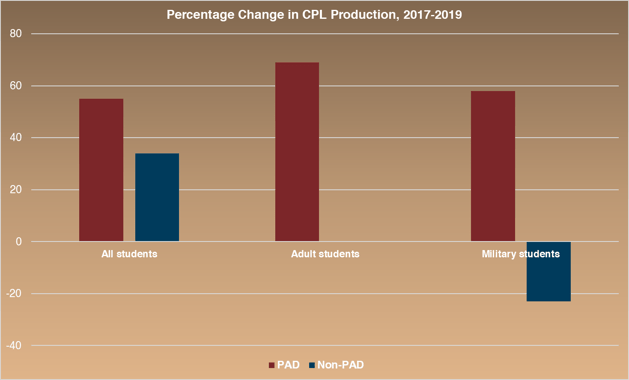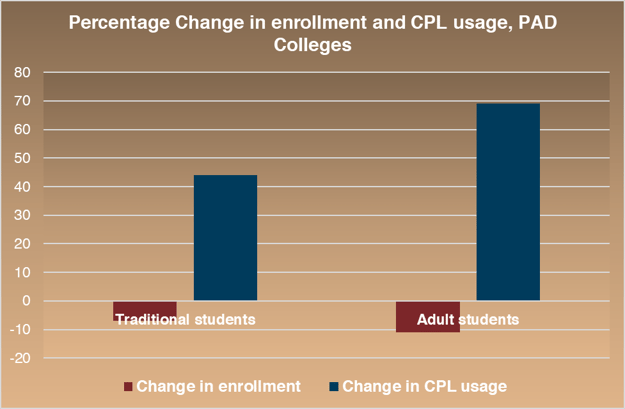Share this
How CPL is Accelerating in Southwest Virginia's Pathways to the American Dream
by Wilson Finch on Jul 01, 2021
In September 2017, CAEL joined an initiative of the New River/Mount Rogers Workforce Development Board (NRMR WDB) to apply a U.S. Department of Labor grant toward improving credit for prior learning (CPL) practices with 9 of Virginia's community colleges in the southwestern part of the commonwealth. This project included partnerships with not only those colleges directly, but also with the Virginia Community College System (VCCS).
The NRMR WDB recognized CPL's potential for advancing the grant's mission to build a talent pipeline of skilled workers in support of regional growth in value-added industries. The grant-backed project, 'Pathways to the American Dream,' (PAD) is funded by the U.S. Department of Labor. It prioritizes credential completion among un- and under-employed adults to enable career success in high-demand occupations.
CPL allows adult learners to parlay the skills and competencies they've developed outside of the classroom into formal college credit, so it's a natural fit for institutions looking for ways to fast-track adult learners to credential completion. As confirmed by CAEL's recent study The PLA Boost, CPL improves completion, saves students time and money, and further benefits institutions as students complete more traditional (purchased) credits in finishing degrees.
The VCCS and NRMR WDB focused CPL efforts on nine Pathways community colleges that, for the most part, are in the state's rural southwest, where displaced workers are an all-too-familiar phenomenon. The nine Pathways institutions are Danville Community College, Lord Fairfax Community College, Mountain Empire Community College, New River Community College, Patrick Henry Community College, Southwest Virginia Community College, Virginia Highlands Community College, Virginia Western Community College, and Wytheville Community College.
CAEL's intake activities included a comprehensive CPL survey and an application of the Adult Learner 360 diagnostic tool for each institution. Adult Learner 360 uses research-validated process benchmarking to gauge institutional effectiveness in serving adult learners. Its parallel surveys capture adult learner and institutional perspectives, revealing strengths and challenges within a gap analysis. CAEL also completed CPL policy reviews for the nine colleges.
Based on these three assessments, CAEL provided professional development for each institution. These activities empowered the institutions to develop and implement improvements to CPL and other adult learner-friendly practices over the following two years. In September of 2020, CAEL repeated the surveys to measure progress.
The nine PAD institutions reported they had adopted more methods of awarding CPL, marketed it more aggressively, and, most importantly, awarded more CPL to students. From 2017 to 2019, the PAD institutions saw an increase in CPL issued for adult learners of 69 percent. Among military students, there was a 58 percent increase in CPL.
Contrasting these outcomes with the other 14 VCCS institutions, which were not a part of the PAD program, provides context. During the same period, CPL for adult learners increased .01 percent and declined 23 percent among military students.

The increases in CPL production occurred against a backdrop of sharply reduced adult learner enrollment. From 2017-2019, PAD colleges saw an 11 percent reduction in adult learners, while non-PAD institutions saw a reduction of 13 percent. This may be evidence that the PAD institutions' latest efforts to improve in CPL and other areas important for adult learning are already impacting persistence and enrollment.
It is certainly evidence that the PAD colleges successfully targeted the intended population of adult students. Although adult learner enrollment declines outpaced reductions in traditional students (11 percent vs. 7 percent), CPL growth was most robust among adult learners.

Several policy changes contributed to the substantial CPL increases. Most of the colleges reported that academic and admissions advisors had increased proactively communicating about CPL. They also increased CPL marketing through social media, printed collateral, and dedicated website pages. Diversity in CPL sources increased, with more colleges reviewing certifications, licenses, challenge exams, and military experience for potential credit. Other enhancements include increased training for faculty and staff, modifications to the amount of CPL allowed, and even wholesale redesigns of CPL policy.
In summarizing the program results, CAEL highlighted several best practices that any institution interested in increasing CPL can implement. Institutions should move from passive policy to active promotion. During the program, PAD institutions used multiple channels to communicate CPL opportunities, including advising and counseling sessions. This helped translate CPL policies from typical internal, academic language to student-relatable dialogue.
Institutions also realized significant benefits by standardizing CPL transcription. Precise articulation of CPL across institutions simplifies the transcription process, allowing transfer advisors to quickly recognize how and for what subject matter a student earned CPL. This helps map CPL earned at one institution to equivalent courses at the transfer institution, lessening the demotivating risk of credit loss during transfer.
Throughout the program, all participating institutions offered faculty and staff professional development even beyond what CAEL provided through the PAD grant. As institutions consider implementing novel methods for assessing prior learning, professional development will help with universal adoption of CPL by increasing awareness and buy-in.
Finally, the PAD institutions studied the possibility of evaluating non-credit offerings for CPL to allow them to stack into for-credit programs. Non-credit offerings can be used to backfill course equivalencies and electives where college-level learning takes place. Local and regional employers may be interested in subsidizing some academic work to complete the associate degree and fill jobs requiring it. LIke all CPL, this will help accelerate degree completion, saving time and money and bolstering student satisfaction.
As is the case with any system, CPL perceptions and outcomes varied across the participating colleges. One constant was that those colleges that made CPL an institutional priority saw the greatest impact from the program. Realizing that CPL is an investment with an ROI that scales with your level of commitment, one college vice president shared that the process has converted him from a prior learning skeptic to a CPL 'true believer.'
Share this
- Adult Learner Success (129)
- CAEL Members (104)
- Success Stories (94)
- Credit for Prior Learning (75)
- Workforce Development (75)
- Impact (70)
- Best Practices (68)
- Career Pathways Support (43)
- Strategic Partnerships (41)
- Work-based Learning (34)
- Trends in Higher Education (32)
- Curation (29)
- Upskilling and Reskilling (29)
- Q&A (23)
- Inclusion (22)
- Policy (21)
- Military-connected Learners (19)
- Talent Management (19)
- Research (18)
- Retention and Completion (18)
- Short-term Credentials (18)
- Adult Learner 360 (17)
- Enrollment (15)
- Student support (12)
- Transfer Students (12)
- Adult Learner Academy (10)
- Competency Based Education (CBE) (10)
- Education Benefits (10)
- In the news (9)
- Student Stories (9)
- Experiential Learning (8)
- Guest blog (8)
- HBCUs (8)
- NACTEL (7)
- Apprenticeships (6)
- Case Studies (6)
- EPCE (6)
- Featured (6)
- HSIs (6)
- Online Learning (6)
- Wraparound Support (6)
- Community colleges (5)
- Credit Predictor Pro (4)
- Future of work (4)
- COVID-19 (3)
- Comebackers (3)
- Structural Approaches to Learning (3)
- Tuition (3)
- Accelerated Program (2)
- Professional development (2)
- Student parents (2)
- Chambers of commerce (1)
- Skills-based hiring (1)
- Upcoming (1)
- December 2025 (4)
- November 2025 (6)
- October 2025 (6)
- September 2025 (13)
- August 2025 (5)
- July 2025 (5)
- June 2025 (11)
- May 2025 (8)
- April 2025 (8)
- March 2025 (8)
- February 2025 (8)
- January 2025 (5)
- December 2024 (5)
- November 2024 (4)
- October 2024 (8)
- September 2024 (7)
- August 2024 (10)
- July 2024 (9)
- June 2024 (8)
- May 2024 (11)
- April 2024 (5)
- March 2024 (7)
- February 2024 (5)
- January 2024 (7)
- December 2023 (10)
- November 2023 (7)
- October 2023 (3)
- September 2023 (4)
- August 2023 (3)
- July 2023 (5)
- June 2023 (8)
- May 2023 (9)
- April 2023 (5)
- March 2023 (6)
- February 2023 (5)
- January 2023 (3)
- December 2022 (4)
- November 2022 (7)
- October 2022 (7)
- September 2022 (6)
- August 2022 (6)
- July 2022 (4)
- June 2022 (6)
- May 2022 (4)
- April 2022 (4)
- March 2022 (3)
- February 2022 (5)
- January 2022 (5)
- December 2021 (4)
- November 2021 (2)
- October 2021 (8)
- September 2021 (4)
- August 2021 (4)
- July 2021 (2)
- June 2021 (6)
- May 2021 (5)
- April 2021 (9)
- March 2021 (8)
- February 2021 (5)
- January 2021 (4)
- December 2020 (4)
- November 2020 (3)
- October 2020 (6)
- September 2020 (2)
- August 2020 (1)
- July 2020 (4)
- May 2020 (2)
- April 2020 (1)
- March 2020 (2)
- February 2020 (2)
- January 2020 (3)
- December 2019 (2)
- July 2019 (1)
- May 2019 (1)
- February 2019 (1)
- January 2019 (1)
- October 2018 (4)
- September 2018 (1)
- August 2018 (1)
- July 2018 (1)
- May 2018 (1)
- April 2018 (2)
- March 2018 (1)
- February 2018 (2)
- September 2017 (1)
- August 2017 (2)
- July 2017 (5)
- June 2017 (4)
- May 2017 (3)
- March 2017 (1)
- February 2017 (4)
- December 2016 (3)
- November 2016 (1)
- October 2016 (3)
- August 2016 (8)
- July 2016 (2)
- June 2016 (2)
- May 2016 (5)
- April 2016 (2)
- March 2016 (6)
- February 2016 (9)
- January 2016 (4)
- January 2015 (2)
